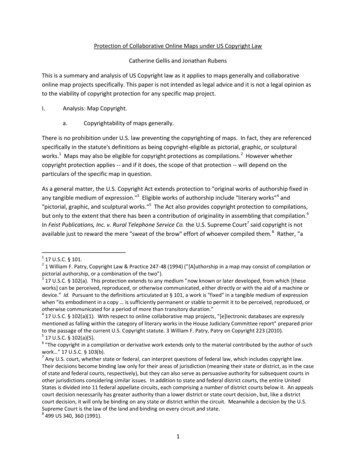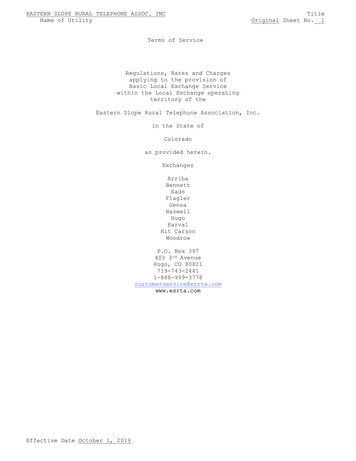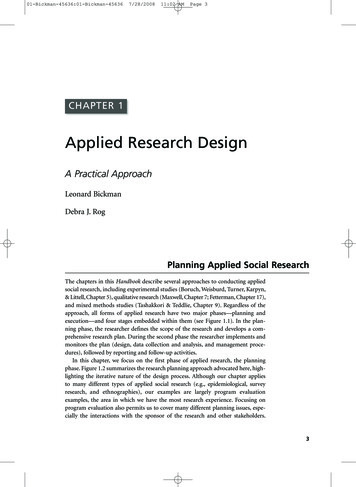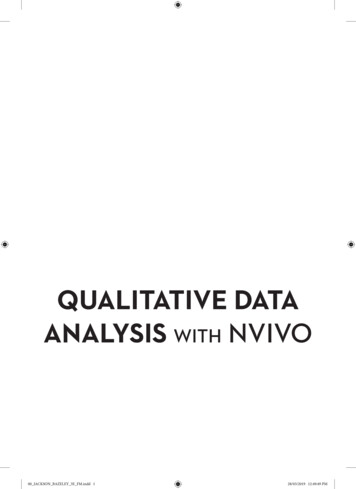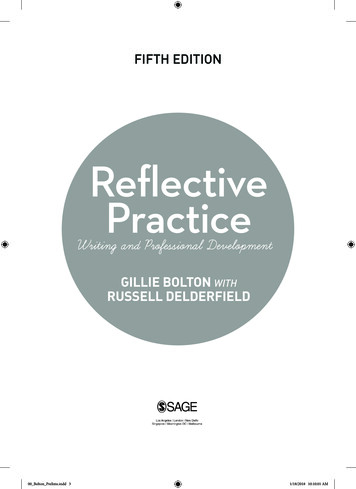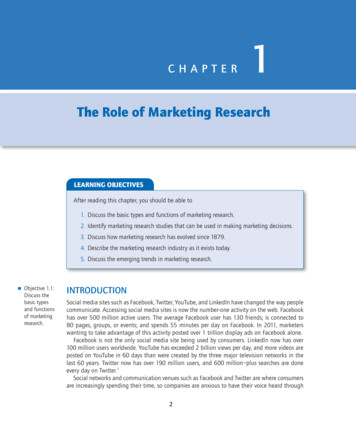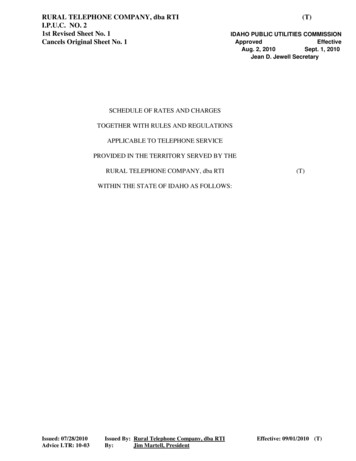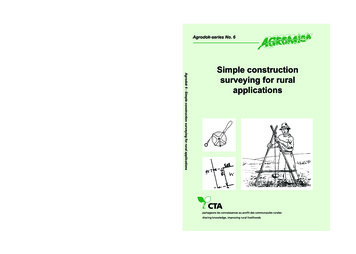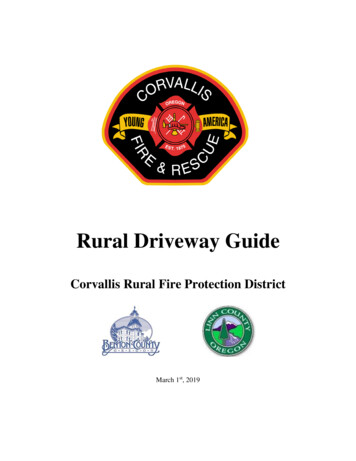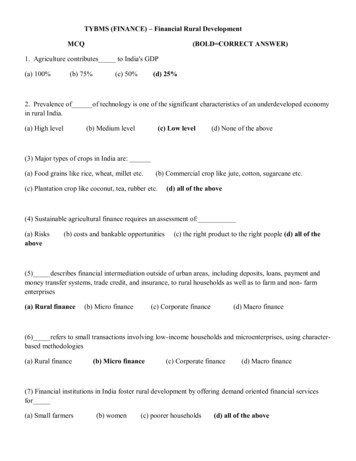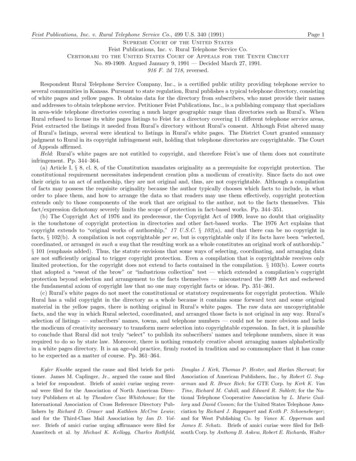
Transcription
Feist Publications, Inc. v. Rural Telephone Service Co., 499 U.S. 340 (1991)Supreme Court of the United StatesFeist Publications, Inc. v. Rural Telephone Service Co.Certiorari to the United States Court of Appeals for the Tenth CircuitNo. 89-1909. Argued January 9, 1991 — Decided March 27, 1991.916 F. 2d 718, reversed.Page 1Respondent Rural Telephone Service Company, Inc., is a certified public utility providing telephone service toseveral communities in Kansas. Pursuant to state regulation, Rural publishes a typical telephone directory, consistingof white pages and yellow pages. It obtains data for the directory from subscribers, who must provide their namesand addresses to obtain telephone service. Petitioner Feist Publications, Inc., is a publishing company that specializesin area-wide telephone directories covering a much larger geographic range than directories such as Rural’s. WhenRural refused to license its white pages listings to Feist for a directory covering 11 different telephone service areas,Feist extracted the listings it needed from Rural’s directory without Rural’s consent. Although Feist altered manyof Rural’s listings, several were identical to listings in Rural’s white pages. The District Court granted summaryjudgment to Rural in its copyright infringement suit, holding that telephone directories are copyrightable. The Courtof Appeals affirmed.Held: Rural’s white pages are not entitled to copyright, and therefore Feist’s use of them does not constituteinfringement. Pp. 344–364.(a) Article I, § 8, cl. 8, of the Constitution mandates originality as a prerequisite for copyright protection. Theconstitutional requirement necessitates independent creation plus a modicum of creativity. Since facts do not owetheir origin to an act of authorship, they are not original and, thus, are not copyrightable. Although a compilationof facts may possess the requisite originality because the author typically chooses which facts to include, in whatorder to place them, and how to arrange the data so that readers may use them effectively, copyright protectionextends only to those components of the work that are original to the author, not to the facts themselves. Thisfact/expression dichotomy severely limits the scope of protection in fact-based works. Pp. 344–351.(b) The Copyright Act of 1976 and its predecessor, the Copyright Act of 1909, leave no doubt that originalityis the touchstone of copyright protection in directories and other fact-based works. The 1976 Act explains thatcopyright extends to “original works of authorship,” 17 U.S.C. § 102(a), and that there can be no copyright infacts, § 102(b). A compilation is not copyrightable per se, but is copyrightable only if its facts have been “selected,coordinated, or arranged in such a way that the resulting work as a whole constitutes an original work of authorship.”§ 101 (emphasis added). Thus, the statute envisions that some ways of selecting, coordinating, and arranging dataare not sufficiently original to trigger copyright protection. Even a compilation that is copyrightable receives onlylimited protection, for the copyright does not extend to facts contained in the compilation. § 103(b). Lower courtsthat adopted a “sweat of the brow” or “industrious collection” test — which extended a compilation’s copyrightprotection beyond selection and arrangement to the facts themselves — misconstrued the 1909 Act and eschewedthe fundamental axiom of copyright law that no one may copyright facts or ideas. Pp. 351–361.(c) Rural’s white pages do not meet the constitutional or statutory requirements for copyright protection. WhileRural has a valid copyright in the directory as a whole because it contains some forward text and some originalmaterial in the yellow pages, there is nothing original in Rural’s white pages. The raw data are uncopyrightablefacts, and the way in which Rural selected, coordinated, and arranged those facts is not original in any way. Rural’sselection of listings — subscribers’ names, towns, and telephone numbers — could not be more obvious and lacksthe modicum of creativity necessary to transform mere selection into copyrightable expression. In fact, it is plausibleto conclude that Rural did not truly “select” to publish its subscribers’ names and telephone numbers, since it wasrequired to do so by state law. Moreover, there is nothing remotely creative about arranging names alphabeticallyin a white pages directory. It is an age-old practice, firmly rooted in tradition and so commonplace that it has cometo be expected as a matter of course. Pp. 361–364.Kyler Knobbe argued the cause and filed briefs for petitioner. James M. Caplinger, Jr., argued the cause and fileda brief for respondent. Briefs of amici curiae urging reversal were filed for the Association of North American Directory Publishers et al. by Theodore Case Whitehouse; for theInternational Association of Cross Reference Directory Publishers by Richard D. Grauer and Kathleen McCree Lewis;and for the Third-Class Mail Association by Ian D. Volner. Briefs of amici curiae urging affirmance were filed forAmeritech et al. by Michael K. Kellogg, Charles Rothfeld,Douglas J. Kirk, Thomas P. Hester, and Harlan Sherwat; forAssociation of American Publishers, Inc., by Robert G. Sug arman and R. Bruce Rich; for GTE Corp. by Kirk K. VanTine, Richard M. Cahill, and Edward R. Sublett; for the Na tional Telephone Cooperative Association by L. Marie Guillory and David Cosson; for the United States Telephone Asso ciation by Richard J. Rappaport and Keith P. Schoeneberger ;and for West Publishing Co. by Vance K. Opperman andJames E. Schatz. Briefs of amici curiae were filed for Bellsouth Corp. by Anthony B. Askew, Robert E. Richards, Walter
Feist Publications, Inc. v. Rural Telephone Service Co., 499 U.S. 340 (1991)Page 2H. Alford, and Vincent L. Sgrosso; for Direct Marketing Asso attractive to potential yellow pages advertisers. In a deci ciation, Inc., by Robert L. Sherman; for Haines and Co., Inc., sion subsequent to that which we review here, the Districtby Jeremiah D. McAuliffe, Bernard A. Barken, and Eugene Court determined that this was precisely the reason RuralGressman; and for the Information Industry Association et refused to license its listings. The refusal was motivatedal. by Steven J. Metalitz and Angela Burnett.by an unlawful purpose “to extend its monopoly in tele phone service to a monopoly in yellow pages advertising.”RuralTelephone Service Co. v. Feist Publications, Inc.,O’Connor, J., delivered the opinion of the Court,737F.Supp. 610, 622 (Kan. 1990).in which Rehnquist, C. J., and White, Marshall,Stevens, Scalia, Kennedy, and Souter, JJ., joined.Unable to license Rural’s white pages listings, FeistBlackmun, J., concurred in the judgment.used them without Rural’s consent. Feist began by re moving several thousand listings that fell outside the ge This case requires us to clarify the extent of copyright ographic range of its area-wide directory, then hired per sonnel to investigate the 4,935 that remained. These em protection available to telephone directory white pages.ployees verified the data reported by Rural and soughtIRural Telephone Service Company, Inc., is a certified to obtain additional information. As a result, a typicalpublic utility that provides telephone service to several Feist listing includes the individual’s street address; mostcommunities in northwest Kansas. It is subject to a state of Rural’s listings do not. Notwithstanding these addi regulation that requires all telephone companies operat tions, however, 1,309 of the 46,878 listings in Feist’s 1983ing in Kansas to issue annually an updated telephone directory were identical to listings in Rural’s 1982-1983directory. Accordingly, as a condition of its monopoly white pages. App. 54 (P 15–16), 57. Four of these werefranchise, Rural publishes a typical telephone directory, fictitious listings that Rural had inserted into its directoryconsisting of white pages and yellow pages. The white to detect copying.Rural sued for copyright infringement in the Districtpages list in alphabetical order the names of Rural’s sub scribers, together with their towns and telephone num Court for the District of Kansas taking the position thatbers. The yellow pages list Rural’s business subscribers Feist, in compiling its own directory, could not use thealphabetically by category and feature classified adver information contained in Rural’s white pages. Rural as tisements of various sizes. Rural distributes its directory serted that Feist’s employees were obliged to travel doorfree of charge to its subscribers, but earns revenue by to-door or conduct a telephone survey to discover thesame information for themselves. Feist responded thatselling yellow pages advertisements.Feist Publications, Inc., is a publishing company that such efforts were economically impractical and, in anyspecializes in area-wide telephone directories. Unlike a event, unnecessary because the information copied wastypical directory, which covers only a particular calling beyond the scope of copyright protection. The Districtarea, Feist’s area-wide directories cover a much larger Court granted summary judgment to Rural, explaininggeographical range, reducing the need to call directory that “courts have consistently held that telephone direc assistance or consult multiple directories. The Feist di tories are copyrightable” and citing a string of lower courtrectory that is the subject of this litigation covers 11 dif decisions. 663 F. Supp. 214, 218 (1987). In an unpub ferent telephone service areas in 15 counties and contains lished opinion, the Court of Appeals for the Tenth Cir 46,878 white pages listings — compared to Rural’s ap cuit affirmed “for substantially the reasons given by theproximately 7,700 listings. Like Rural’s directory, Feist’s district court.” App. to Pet. for Cert. 4a, judgt. orderis distributed free of charge and includes both white pages reported at 916 F. 2d 718 (1990). We granted certiorari,and yellow pages. Feist and Rural compete vigorously for 498 U.S. 808 (1990), to determine whether the copyrightin Rural’s directory protects the names, towns, and tele yellow pages advertising.As the sole provider of telephone service in its service phone numbers copied by Feist.II — Aarea, Rural obtains subscriber information quite easily.Persons desiring telephone service must apply to RuralThis case concerns the interaction of two welland provide their names and addresses; Rural then as established propositions. The first is that facts are notsigns them a telephone number. Feist is not a telephone copyrightable; the other, that compilations of facts gen company, let alone one with monopoly status, and there erally are. Each of these propositions possesses an im fore lacks independent access to any subscriber informa peccable pedigree. That there can be no valid copyrighttion. To obtain white pages listings for its area-wide di in facts is universally understood. The most fundamentalrectory, Feist approached each of the 11 telephone com axiom of copyright law is that “no author may copyrightpanies operating in northwest Kansas and offered to pay his ideas or the facts he narrates.” Harper & Row, Pub for the right to use its white pages listings.lishers, Inc. v. Nation Enterprises, 471 U.S. 539, 556Of the 11 telephone companies, only Rural refused to (1985). Rural wisely concedes this point, noting in itslicense its listings to Feist. Rural’s refusal created a prob brief that “facts and discoveries, of course, are not them lem for Feist, as omitting these listings would have left selves subject to copyright protection.” Brief for Respon a gaping hole in its area-wide directory, rendering it less dent 24. At the same time, however, it is beyond dispute
Feist Publications, Inc. v. Rural Telephone Service Co., 499 U.S. 340 (1991)Page 3that compilations of facts are within the subject matter be protected are the fruits of intellectual labor, embodiedof copyright. Compilations were expressly mentioned in in the form of books, prints, engravings, and the like.”the Copyright Act of 1909, and again in the Copyright Ibid. (emphasis in original).Act of 1976.In Burrow-Giles, the Court distilled the same require There is an undeniable tension between these two ment from the Constitution’s use of the word “authors.”propositions. Many compilations consist of nothing but The Court defined “author,” in a constitutional sense, toraw data — i. e., wholly factual information not accom mean “he to whom anything owes its origin; originator;panied by any original written expression. On what basis maker.” 111 U.S., at 58 (internal quotation marks omit may one claim a copyright in such a work? Common sense ted). As in The Trade-Mark Cases, the Court empha tells us that 100 uncopyrightable facts do not magically sized the creative component of originality. It describedchange their status when gathered together in one place. copyright as being limited to “original intellectual con Yet copyright law seems to contemplate that compilations ceptions of the author,” 111 U.S., at 58, and stressed thethat consist exclusively of facts are potentially within its importance of requiring an author who accuses another ofscope.infringement to prove “the existence of those facts of orig The key to resolving the tension lies in understand inality, of intellectual production, of thought, and concep ing why facts are not copyrightable. The sine qua non of tion.” Id., at 59–60.The originality requirement articulated in The Tradecopyright is originality. To qualify for copyright protec tion, a work must be original to the author. See Harper & Mark Cases and Burrow-Giles remains the touchstone ofRow, supra, at 547–549. Original, as the term is used in copyright protection today. See Goldstein v. California,copyright, means only that the work was independently 412 U.S. 546, 561–562 (1973). It is the very “premise ofcreated b
Respondent Rural Telephone Service Company, Inc., is a certified public utility providing telephone service to several communities in Kansas. Pursuant to state regulation, Rural publishes a typical telephone directory, consisting of white pages and yellow pages. It obtains data for the directory from subscribers, who must provide their names
